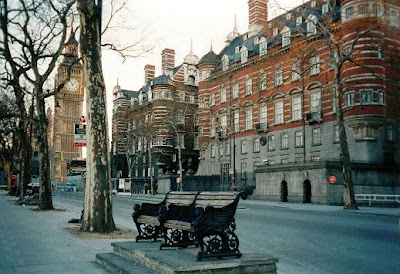

(These photographs were taken from the internet.)
The following is a reprint of an article I wrote for the Noose, the newsletter for Mystery Writers of America.
INSIDE SCOTLAND YARD
Securing order, preventing crime and the detection and punishment of offenders, if a crime is committed, is the primary objective of any police force. Jeremy Taylor, the MWA guest for our November meeting, talked about his involved in this endeavor for 30 years with the Metropolitan Police of London, first working as an uniformed officer with a Westminster beat, then as a detective for 27 years on the International scene.
The British police system has roots that date back to the first Saxons. Initially the community was divided into groups of ten, called “tythings”, with one tything-man appointed as a representative of each group. The community was then divided into larger groups of ten tythings, and these were placed under the jurisdiction of a “hundred-man” who was then responsible to the shire-reeve, or Sheriff, of the country.
This system of policing would become modified during the feudalism period. The tything-man became the parish constable and the Shire-reeve the Justice of the Peace, to whom the parish constable was responsible. This became the main system of overseeing the populace during the seventeenth and early eighteenth centuries, and was generally made up of an unarmed able-bodied citizen in each parish called a parish constable. The constable, appointed or elected, served unpaid for a year and worked cooperatively with the Justices in securing observance of laws and maintaining order. Later, a group of paid citizens, known as “The Watch” would be established to guard the gates and patrol the streets at night. During the eighteenth century the tremendous increase in population in the towns, brought with it immense social and economic change and the old system of policing failed to meet the needs of the changing times which led to the formation of the “New Police.” In 1839 the first Metropolitan Police act was passed and the Metropolitan Police force was established.
The job of organizing and designing the “New Police” was placed in the hand of Colonel Charles Roman and Richard Mayne. These two Commissioners occupied a private house at 4, Whitehall Place, the back of which opened on to a courtyard. The back premises of 4, Whitehall Place were used as a police station, and it was this address that led to the headquarters of Metropolitan Police to become known as Scotland Yard.
There are two stories about how Scotland Yard got its name. One versions is that this location had once been the site of a residence owned by the Kings of Scotland, and another version is that 4, Whitehall Place backed onto a court called Great Scotland Yard, property said to be owned by a man called Scott during the Middle Ages.
In 1890 the headquarters were moved to premises on the Victoria Embankment and became know as “New Scotland Yard” and then in 1967 a more modern headquarters was build at Broadway, S.W. 1 which is also know at “New Scotland Yard.”
When Jeremy Taylor joined the Metropolitan Police as an uniformed officer in 1961 his primary objective was to deal with incorrigible rogues and vagabonds and the prevention of crime. Police officers in the Met are not issued guns or hand cuffs, but are given clubs called truncheons. However, the officers are not allowed to use their truncheons and the clubs must keep concealed at all times. Whistles are a basic part of the equipment issued to an officer, but are to be used only in an emergency. If an officer were to find himself in trouble he is expected to blow the whistle loudly three times. Or, if it is night and he is using his torch he is to flash the light off and on three times in the direction of another officer. The use of radios, according to what Taylor said, is thought to lessen the senses and is therefore discouraged.
After Taylor and other new recruits were shown their first dead body, he and the other officers in the room were all then given a stiff whisky in various glasses. Once they had finished the drinks they were told that what these glasses had in common was that they were the glasses of suicides.
In 1974 Taylor was sent to work in Greece, Cypress and Turkey where he dealt with spy cases. His first involvement with a bomb came in 1978, which was before the days of forensic science, and the only assistance in dealing with such situations had been X Rays. So Taylor, his fellow officers and the head of his division, on that first day when confronted with this potentially dangerous item, looked into the wooden box with the assistance of the X Ray machine, and, indeed saw wires, batteries and a detonator. They had a bomb on their hands all right, and, as he put it, they all had a cup of tea before deciding how to go about dismantling this explosive device.
Times have changed a great deal since those early days when Taylor first worked in the International arena dealing with the monitoring of spying. He said that most of his old department now focuses on International Terrorism. Taylor retired ten years ago and divides his time between working on a board that oversees a retirement home in the country and enjoying opera.
The New Scotland Yard can be contacted in writing at: New Scotland Yard, Broadway, London, SWIH OBG. The phone number for New Scotland Yard is 020-7230 1212. But in an emergency when in London always dial 999. E-mail inquiries can be sent to new.scotland.yard@met.police.uk and they aim to respond within ten days.

1 comment for “SCOTLAND YARD”